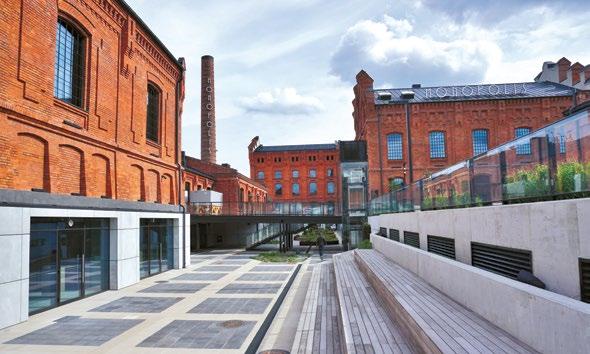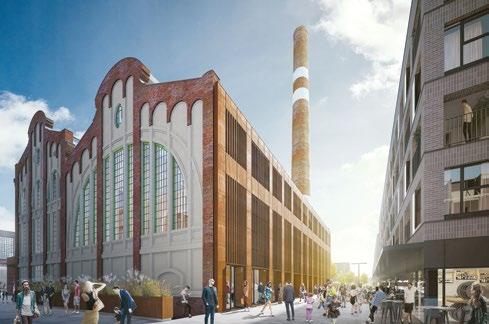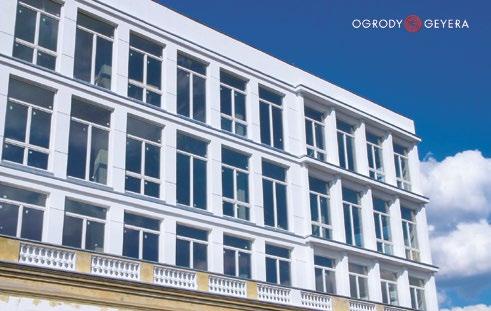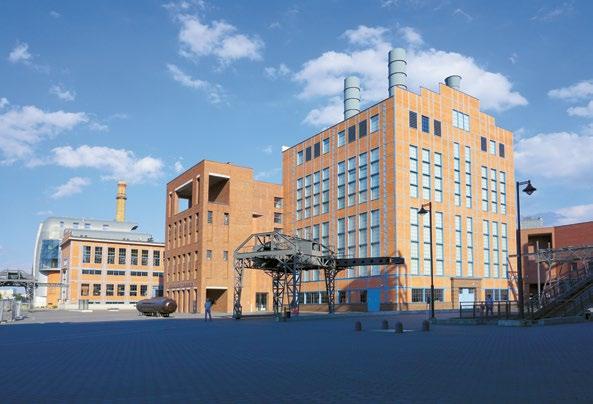
7 minute read
The second life of Łódź factories
A city within a city. With restaurants, a bakery, theatre, art gallery and museum. This is Monopolis. This fashionable and revitalised space – which combines tradition and modernity – a few years ago was one of those places that could have fallen into decline and turned into ruin after the collapse of its industry.
The office, entertainment and cultural centre Monopolis is located in the third largest post-industrial complex in Łódź on 62 Kopcińskiego Street. The complex of red-brick buildings was erected at the turn of the nineteenth and twentieth century and was the home of an alcohol production plant, which operated until the early twenty-first century. When the last bottle of vodka was made on the 27 th of April 2007, and the plant ceased its activities on the 1 st of June 2008, one of the showpieces of the Łódź factory landscape was waiting for better times. These came in 2013 when a new owner of the whole area appeared – Virako, which a year later announced that the former ‘Monopol Wódczany’ Spirits Factory Complex was beginning its transformation into Monopolis.
Advertisement
The transformation required a lot of work and money (according to muratorplus.pl, it has so far cost about PLN 150,000,000). The Monopolis will offer 23,400 square metres of Class A office space, located in two new office buildings (9 – and 11-storey high), 5,000 square metres of space for catering services, a vodka production museum, a city gallery and even a private theatre. There will also be a recreational swimming pool, a gym, a kindergarten and a community centre for children. You will be able to relax in two pocket parks and on six green roof terraces.
The construction of the Monopolis is underway. In July this year, a 56-metrehigh crane was ready to erect the other office building. Of the twelve storeys, the lower ones will refer to the brick buildings of the former Polmos facility, while the upper ones will have a modern glazed form. Not only is the new office building but the whole Monopolis a combination of tradition and modernity, most of private revitalisations are carried out in a similar manner.
Fuzja, located on 5/7 Tymienieckiego Street, is another example of such an investment. This will be called a destination place. What does it mean? The investor, Echo Investment, explains: A small district with a characteristic and unique atmosphere. For the inhabitants of Łódź – a meeting place in the very heart of the city; for visitors – a great attraction to see and spend some nice time in. Both groups will meet in Fuzja as designs of destination places attract by definition.
The heart of Fuzja will be a historic com - bined heat and power plant, which was commissioned in 1910 to make the industrial empire of Karol Scheibler independent of external power supplies. The power plant of the Cotton Products Society was built according to a design by Alfred Frisch, who resigned from the neo-Renaissance and neo-Baroque style – characteristic of industrial buildings in Łódź – and focused on modernity, i.e. Art Nouveau and modernism.
The power plant, which was supposed to intimidate and be a showcase of the power of the Scheibler family, remained in operation until 2003. The building, in which some of the equipment (including a turbine from 1935) has been preserved, will again show the process of restoring degraded areas of the city to life. Thanks to this investment Łódź does not only get
Fuzja, which heart will be a historic combined heat and power plant, which was commissioned in 1910.

a few buildings, a new square for the local community or a renovated street. A whole fragment of the city is brought back to life – a small district designed according to a coherent concept that respects the city, its unique character and its inhabitants – we can read on the website of Fuzja.
Big changes also await the Widzew Cotton Industry Plant ‘Wi-Ma’. One of the most interesting post-industrial complexes in Łódź, located on 135 Piłsudskiego Street, is today a place where companies from the creative industry operate. In March this year, during an extraordinary session, city councillors approved the plans of the landowner, i.e. Cavatina Holding from Krakow, who wants to thoroughly modernise the place and transform it into an office and residential area. The buildings of the spinning mill and dyeing plant will be rebuilt and gain additional storeys. Both the revitalised historic buildings and the new area will provide space for offices, trade and services. Over 400 flats will also be built, together with multi-storey car parks.

Widzew Cotton Industry Plant ‘Wi-Ma’.
Life has also returned to Geyer Gardens, which have been revitalised since 2017. This is another place vibrant with the atmosphere of industrial Łódź, which today combines business, entertainment and cultural life. The whole area covers over 10 hectares and is situated between Piotrkowska, Czerwona, Wolczańska and Sieradzka Streets. Years ago, there were textile factories here owned by Ludwik Geyer – an important figure in the history of Łódź, one of the pioneers

Geyer tenement house. in the development of the textile industry, owner of the first steam-powered textile factory in the Kingdom of Poland. Born in Berlin, Geyer came to Łódź in 1828 and needed only a few years to become one of the most prominent entrepreneurs in the city.
The place in the heart of Łódź, where Geyer’s products – valued throughout the Kingdom of Poland and the Russian Empire – were made, gained a second life thanks to Miss Domain, a subsidiary of Monnari Trade, which acquired the property in 2016. Space for catering services, trade, cultural centres and residential dwellings has been planned. This is another point on the map of Łódź where a revitalised post-industrial space will be combined with new buildings.
A similar atmosphere can be experienced in the New Centre of Łódź – a new business, tourist and residential district, where the largest revitalisation projects – both public and private – are underway. Another one will commence soon on 64 Tuwima Street. A tender for the sale of a city property located in the immediate vicinity of the recently revitalised EC1 Science and Tech nology Centre and the modernised Łódź Fabryczna railway station was won at the end of May by Vantage Development based in Wroclaw. The company offered more than PLN 8,500,000. What are its plans? A historic warehouse located on the plot of land will be renovated with small business in mind. It will house retail and service outlets, as well as catering and entertainment facilities. Furthermore, the investment will provide about 240 institutionally managed apartments for rent.

Geyer Gardens is another point on the map of Łódź where a revitalised post-industrial space will be combined with new buildings.
EC1 Science and Technology Centre.
The face of the city is also changed by smaller projects such as the revitalisation of individual historic tenement houses. Probably the fact that real estate prices in Łódź are significantly lower than in other major Polish cities, investors see the prospect of a high rate of return here. We can already talk about a certain investment fashion for loft apartments and office space in old, meticulously renovated tenement houses and post-industrial buildings.
One of the companies that focuses its activities in this area is Vision Development. Representatives of the company explain: It gives us great satisfaction and is a proud fact that by implementing new construction projects we can participate in the continuous development of the city and protect the rich history and architectural heritage of Łódź by undertaking ambitious projects involving historic and often forgotten buildings. Vision Development has undertaken, among other things, the revitalisation of a historic tenement house on 44 Piotrkowska Street, together with the new development in the second stage of the project.

This is just one example of such transformations. Another historic building, erected in 1892, is being renovated by Revisit Home. The Hanging Gardens Apartments is almost 3,000 square metres of space in the city centre (48 Tuwima Street), where 41 apartments and three commercial units will be built. Art Modern lofts on 8 Wróblewskiego Street, located in a restored former steam power plant from the 19 th century – the only remnant of the factory complex of Karol Weile and Stanisław Landau – are also very popular.
The authorities of Łódź emphasise that the aim of the revitalisation efforts, spread over many years, is not only to renovate buildings. The true value is to bring back to life the degraded part of the city and complement it with new functions. Introducing such changes will allow living, working and spending free time better. And, most importantly, the revitalisation also means working with people, which is aimed at overcoming the social crisis. This cannot be done by the city alone. Broad cooperation and investors who understand the real purpose of revitalisation are needed. Fortunately, there are more and more investors in Łódź who, every year, notice the potential for revitalisation.
More information:
Business Development and International Relations Bureau
104a Piotrkowska Street, 90-926 Lodz Phone: +48 42 638 59 39 Fax: +48 42 638 59 40 e-mail: boi@uml.lodz.pl









